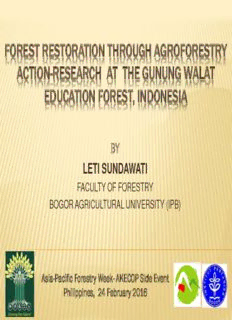
Forest restoration through agroforestry at the Gunung Walat Education Forest, Indonesia, Leti ... PDF
Preview Forest restoration through agroforestry at the Gunung Walat Education Forest, Indonesia, Leti ...
FOREST RESTORATION THROUGH AGROFORESTRY ACTION-RESEARCH AT THE GUNUNG WALAT EDUCATION FOREST, INDONESIA BY LETI SUNDAWATI FACULTY OF FORESTRY BOGOR AGRICULTURAL UNIVERSITY (IPB) Asia-Pacific Forestry Week- AKECOP Side Event Philippines, 24 February 2016 INTRODUCTION Gunung Walat Educational Forest (GWEF) at Sukabumi District, Indonesia established since 1973 by Faculty of Forestry, Bogor Agricultural University. About 350 ha forest area covered by very good vegetation dominated by Agathis (Agathis lorantifolia) and Pine (Pinus merkusii). 1997-2000 the GWEF faced a rapid degradation due to illegal cutting and encroachment by local people who were mostly landless and unemployed due to economic crisis. About 200 households encroached about 75 ha of the GWEF area, so difficult or even impossible to expel them from the forest area. To restore the forest area and improve the livelihood of the community surrounding the GWEF, an agroforestry action research project was the only possible promising solution. Supported by Korean Government through ASEAN-Korea Environemnetal Cooperation Project (AKEOP) for two project phases in 2001-2004 and 2005-2008, the forest restoration through agroforestry action research was then implemented in the GWEF LOCATION OF THE GUNUNG WALAT EDUCATIONAL FOREST (GWEF) Halimun-Salak National Park Gede Pangrango National Park GWEF ILLEGAL ACTIVITIES BY LOCAL PEOPLE AT GWEF Why conserving and preventing further degradation of the GWEF was very important, so that an agroforestry action research project was implemented at the Gunung Walat Educational Forest ? IMPORTANCE OF THE GWEF FOR LOCAL PEOPLE APPROACH TAKEN An action research using participatory approach through involving local people in the establishment of agroforestry system was applied and supported with various researches on biophysical as well as socio-economic aspects. PRINCIPLES: The people living in and surrounding the forest must and need to a. be concerned in developing forestry sector in Indonesia, because they are integrated part of forest ecosystem, most of them deserve justice after being neglected and set aside for long time, have shown big power which could seriously destructive if being ignored and could be supportive if given enough concern (Darusman, 2000), The change of forestry paradigm from protecting the forest from b. community to involving community in forest management (van Gelder and O’Keefe , 1995), The conceptual changes needed in the forestry management into c. forest management based on partnership and participation (Campbell, 1997) APPROACH (CONT.) Establishment of agroforestry at forest area was not a new concept in Indonesia. The Dutch started it in the beginning of 19’s century for teak forest establishment in Java and continue until now by Perhutani (State Forest Enterprise). What was new then in the project? a. Trees and crops planted at agroforestry system in the GWEF were selected according to the local people preference instead of decided by forest manager, i.e. sengon (Paraserianthes falcataria) and already existing Agathis loratifolia as trees component and coffee (Coffea robusta), banana, cassava, cardamom as agriculture crops component b. The local people were allowed to manage the agroforestry plots for 10 years (only 2 year in Perhutani, at that time) with possible extension under agreement between farmers and the management of GWEF. c. Training and extension for farmers on agroforestry management were conducted to improve their capability. AGROFORESTRY DESIGN Agathis dammara (50 x 10 m) P ParaP Paraserianthes falcataria (50 x 10 m) Banana Pineaple Chili Figure 2. First design of agroforestry sy Rice/Corn/Peanuts Figure 2 : First and Second Design of Agroforestry System Agathis dammara Banana Cardamon Coffea Figure 3 : Third Design of Agroforestry System PROJECT LOCATION AT GUNUNG WALAT EDUCATIONAL FOREST Batununggal Village Batununggal Village Agathis Pine Agathis Pine Hegarmanah Cicantayan Village Village Hegarmanah Village Quickbird Image 2007 (359 Ha)
Description: